Finding a cooler that has just the appropriate size and function for your lifestyle might be challenging. Many inquiries, such as: “How big is a 20-quart cooler? “Can it accommodate my needs?” So that you may discover exactly what you need, we have provided a broad range of cooler sizes and types in this blog post.
1. What capacity does a 20-quart cooler have?
A quart is one-fourth of a gallon. It’s typical to see cooler sizes stated alongside products in quarts, such as a 24-quart or 70-quart cooler.
In general, a normal 20-quart wine cooler can hold 16 to 18 drink cans and 20 pounds of ice. It can also fit up to four standard wine bottles with no problems.
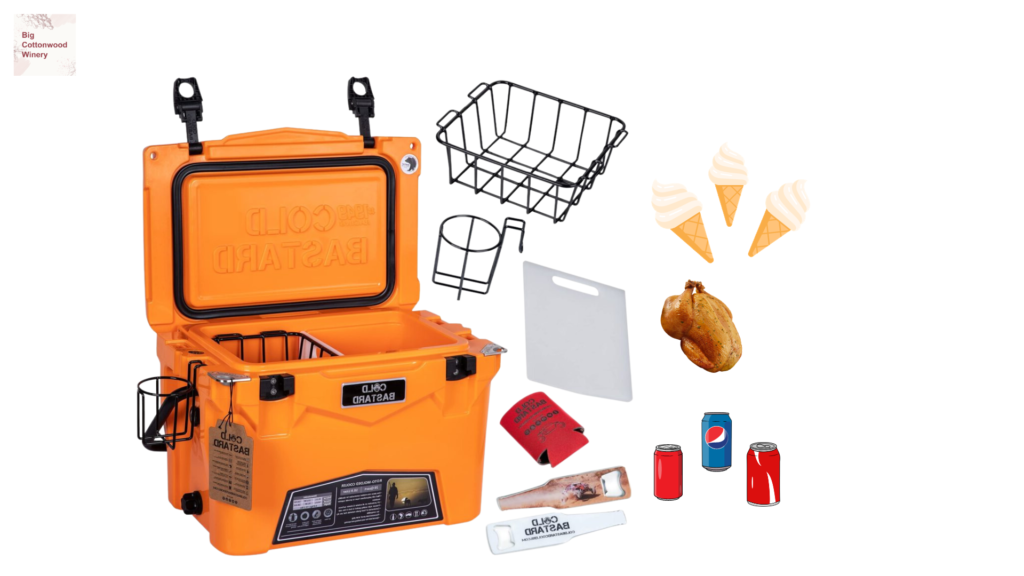
In the section below, we list the best 20-quart coolers on the market with their specs and capacities.
- Driftsun 20-Quart Ice Chest: has the ability to handle both 18 drink cans and 12 pounds of ice at once.
- Giantex 20 Quart: can hold 14 pounds of ice and 20 drink cans.
- Grizzly 20 Cooler: to maintain the icy coldness of up to 24 drink cans and 5 lbs (2.3kg) of food.
- RTIC Soft Cooler 22: has the capacity of 30 drink cans, plus ice.
- Orca Coolers 20: 15 bottles or up to 18 drink cans may be chilled simultaneously for up to 10 days.
- YETI Hopper Flip: can keep 24lbs (10.9kg) of ice or up to 20 beverage cans warm for several days.
- Pelican 20 Quart Elite Cooler: keeps up to 15 drink cans or 19 lbs (8.6kg) of ice during your trip.
- CAMP-ZERO 20L Cooler: can hold up to 22 drinks cans plus ice.
2. How long will a 20-quart cooler keep ice cold?
In favorable conditions (moderate outside temperature, high-quality cooler, good ice-to-contents ratio), a 20-quart cooler could potentially keep ice cold for 2 to 4 days or more. However, in extremely hot weather, this duration may be shorter, perhaps 1 to 2 days.
For extended periods of ice retention, consider using additional strategies like pre-chilling the cooler, using ice packs, and minimizing the frequency of opening the cooler to keep it closed and the contents colder for longer.
3. What are the benefits of using a 20-quart cooler?
Here are some benefits when using a 20-quart cooler:
- Portability: A 20-quart cooler is a good size for most people and is still small enough to be easily portable. This makes it a great choice for day trips, weekend camping trips, or even just a picnic in the park.
- Durability: 20-quart coolers are typically made of durable materials, such as plastic or rotomolded plastic, which can withstand rough handling. This makes them a good choice for activities where the cooler may be exposed to the elements or dropped.
- Affordability: 20-quart coolers are typically more affordable than larger coolers. This makes them a good option for people who are on a budget or who only need a cooler for occasional use.
- Versatility: A 20-quart cooler can be used for a variety of purposes, such as keeping food and drinks cold, transporting bait, or even storing tools. This makes it a versatile and practical choice for many people.
- Ease of use: 20-quart coolers are typically easy to use and maintain. They typically have a simple design with few moving parts, which makes them easy to clean and care for.
4. What are the drawbacks of using a 20-quart cooler?
While 20-quart cooler has convenient for many situation, using a 20-quart cooler does have some drawbacks to consider:
- Limited Capacity: A 20-quart cooler is relatively small, making it suitable for day trips, picnics, or small gatherings. However, it may not provide enough storage space for larger events or extended trips.
- Limited Ice Retention: Smaller coolers typically have less insolation than larger models. This means that a 20-quart cooler may not keep ice as cold for as long as larger, more insulated coolers. If you need extended ice retention, especially in hot weather, you might need to replenish the ice more frequently.
- Less Versatility: Due to its compact size, a 20-quart cooler may not accommodate larger items or awkwardly shaped containers. This can limit its versatility in certain situations.
- Portability Overload: While smaller coolers are more portable, a 20-quart cooler can become heavy when filled with ice and beverages. It might be less convenient to carry over long distances.
- Limited Features: Smaller coolers may lack some of the advanced features found in larger models, such as dividers, multiple compartments, or built-in accessories.
- Limited Seating: Some larger coolers are designed with lids that can double as seats. A 20-quart cooler usually does not offer this feature.
- Less Durability: Smaller coolers may not be as rugged or durable as their larger counterparts, especially if they are not made from heavy-duty materials.
- Price: While 20-quart coolers are generally more affordable than larger coolers, high-quality models with advanced insulation can still be relatively expensive.
5. How do I choose the right 20-quart cooler for me?
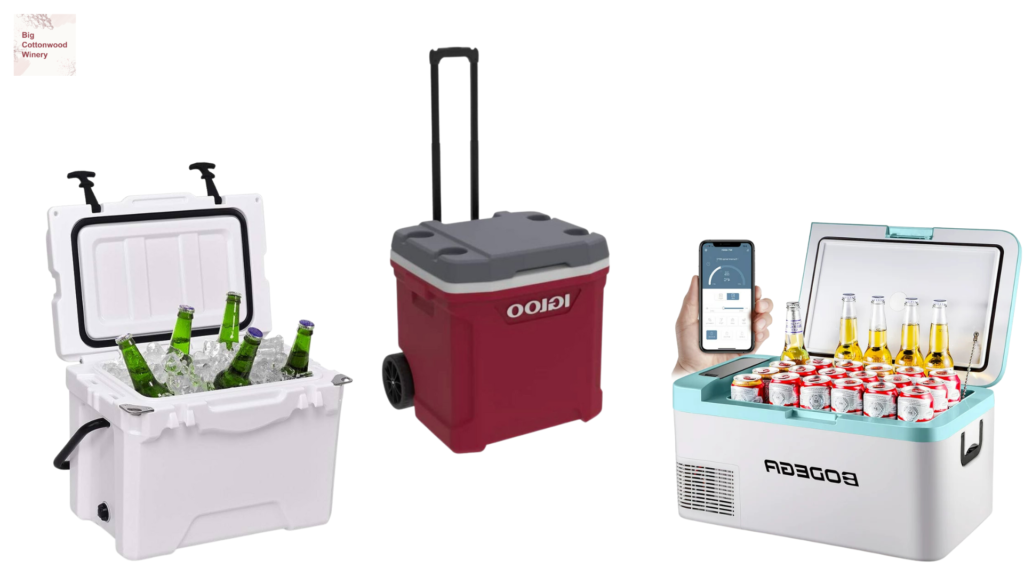
Choosing the right 20-quart cooler involves considering your specific needs and preferences. Here are some factors to keep in mind when selecting a 20-quart cooler:
- Insulation Quality: Look for coolers with high-quality insulation. Brands like YETI, Pelican, and Engel are known for their excellent insulation properties.
- Ice Retention: Consider how long you need the cooler to keep ice cold. Some models are designed for extended ice retention, while others are better for shorter trips.
- Intended Use: Think about the primary use of the cooler. Will you use it for day trips, picnics, camping, or other activities? Different activities may require different features.
- Durability: Check the build quality and materials of the cooler. Rotomolded coolers are known for their durability and ruggedness.
- Portability: Evaluate the cooler’s weight and whether it has features like handles, shoulder straps, or wheels for easy transportation.
- Features: Consider any additional features you might want, such as built-in cup holders, dividers, bottle openers, or cutting boards.
- Price: Set a budget for your cooler. Higher-end models with advanced features and better insulation tend to be more expensive.
- Brand Reputation: Research brands and read reviews to ensure you’re choosing a reputable and reliable cooler.
- Warranty: Check if the cooler comes with a warranty, as this can provide peace of mind regarding its quality and durability.
- Size and Capacity: While you’re specifically looking for a 20-quart cooler, consider the dimensions and storage capacity within the cooler. Ensure it can accommodate your needs.
- Ease of Cleaning: Look for coolers that are easy to clean and maintain.
- Compatibility: If you have specific accessories or items you plan to store in the cooler, ensure it can accommodate them.
- Aesthetics: While not the most critical factor, the cooler’s appearance might matter to you, especially if you have color or design preferences.
- User Reviews: Read reviews from other users to get insights into real-world performance and durability.
6. What are the best 20-quart coolers?
1. RTIC 20 Qt
The RTIC 20 Qt is a well-made cooler with a number of features that make it a great choice for travel. It is heavier than some other coolers, but the build quality and details make it worth the extra weight.
The rubber gaskets on the drain plugs help to keep the contents cold, and the bear locks and locking handle help to keep your food secure. If you are looking for a high-quality cooler that is built to last, the RTIC 20 Qt is a great option.
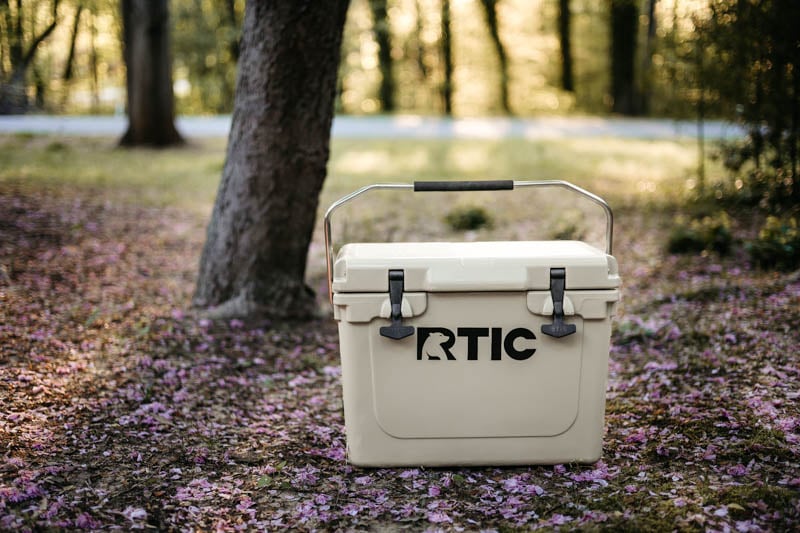
1.1. Features
- 3-inch thick insulation: The RTIC 20 Qt has 3-inch thick insulation, which helps to keep the contents cold for longer periods of time.
- Rubber gaskets on the drain plugs: The drain plugs have rubber gaskets to help prevent leaks.
- Two spots for bear locks: The RTIC 20 Qt has two spots for bear locks, which can be used to keep your food secure in bear country.
- Locking mechanism for the stainless steel handle: The stainless steel handle has a locking mechanism to prevent it from accidentally opening.
- Drainage system: The RTIC 20 Qt has a drainage system that makes it easy to drain the melted ice.
- Durable construction: The RTIC 20 Qt is made of durable materials that can withstand rough handling.
- Warranty: The RTIC 20 Qt comes with a lifetime warranty.
1.2. Things we like
- The RTIC 20 Qt is made of durable materials that can withstand rough handling.
- The RTIC 20 Qt has 3-inch thick insulation, which helps to keep the contents cold for longer periods of time.
- The drain plugs have rubber gaskets to help prevent leaks.
- The RTIC 20 Qt has two spots for bear locks, which can be used to keep your food secure in bear country.
- The stainless steel handle has a locking mechanism to prevent it from accidentally opening.
- The RTIC 20 Qt has a drainage system that makes it easy to drain the melted ice.
- The RTIC 20 Qt comes with a lifetime warranty.
- The RTIC 20 Qt is a relatively affordable cooler.
1.3. Things we don’t like
- The RTIC 20 Qt is heavier than some other coolers.
- The RTIC 20 Qt is not as large as some other coolers.
- The RTIC 20 Qt is not as well-known as the Yeti cooler, which may make it more difficult to find replacement parts or accessories.
1.4. Editor’s Note
The RTIC 20 Qt is a well-made cooler that offers a good balance of features, performance, and price. It is the heaviest of the coolers I tested, but the build quality and details make it my favorite of the small hard-sided coolers.
I would recommend the RTIC 20 Qt to anyone looking for a durable and reliable cooler that offers good value for the price. It is not the lightest or largest cooler on the market, but it makes up for it with its build quality and features.
1.5. FAQs
1.5.1. How much ice does the RTIC 20QT hold?
The RTIC 20QT can hold up to 24 cans of soda or beer plus ice. However, the actual amount of ice that the cooler will hold will depend on the type of ice you use, how tightly you pack the cooler, and the ambient temperature.
1.5.2. How long will the ice in the RTIC 20QT last?
The RTIC 20QT can keep ice cold for up to 3 days in ideal conditions. However, the actual amount of time that the ice will last will depend on the ambient temperature, how often you open the cooler, and how much ice you use.
1.5.3. Is the RTIC 20QT bear-proof?
The RTIC 20QT is not bear-proof. However, it does have two spots for bear locks, which can be used to secure the cooler in bear country.
1.5.4. What is the warranty on the RTIC 20QT?
The RTIC 20QT comes with a lifetime warranty. This means that RTIC will repair or replace the cooler if it ever breaks or malfunctions.
2. YETI Roadie 24
The YETI Roadie 24 is a high-quality cooler that performs well in ice retention and insulation tests. It is also easy to use, with a tall and slim exterior and effortless latches. However, it is the most expensive cooler on the market.
The unique shape of the Roadie 24 makes it not ideal for storing only beer cans. However, it is great for packing a variety of goods, such as food and drinks for an overnight camping trip.
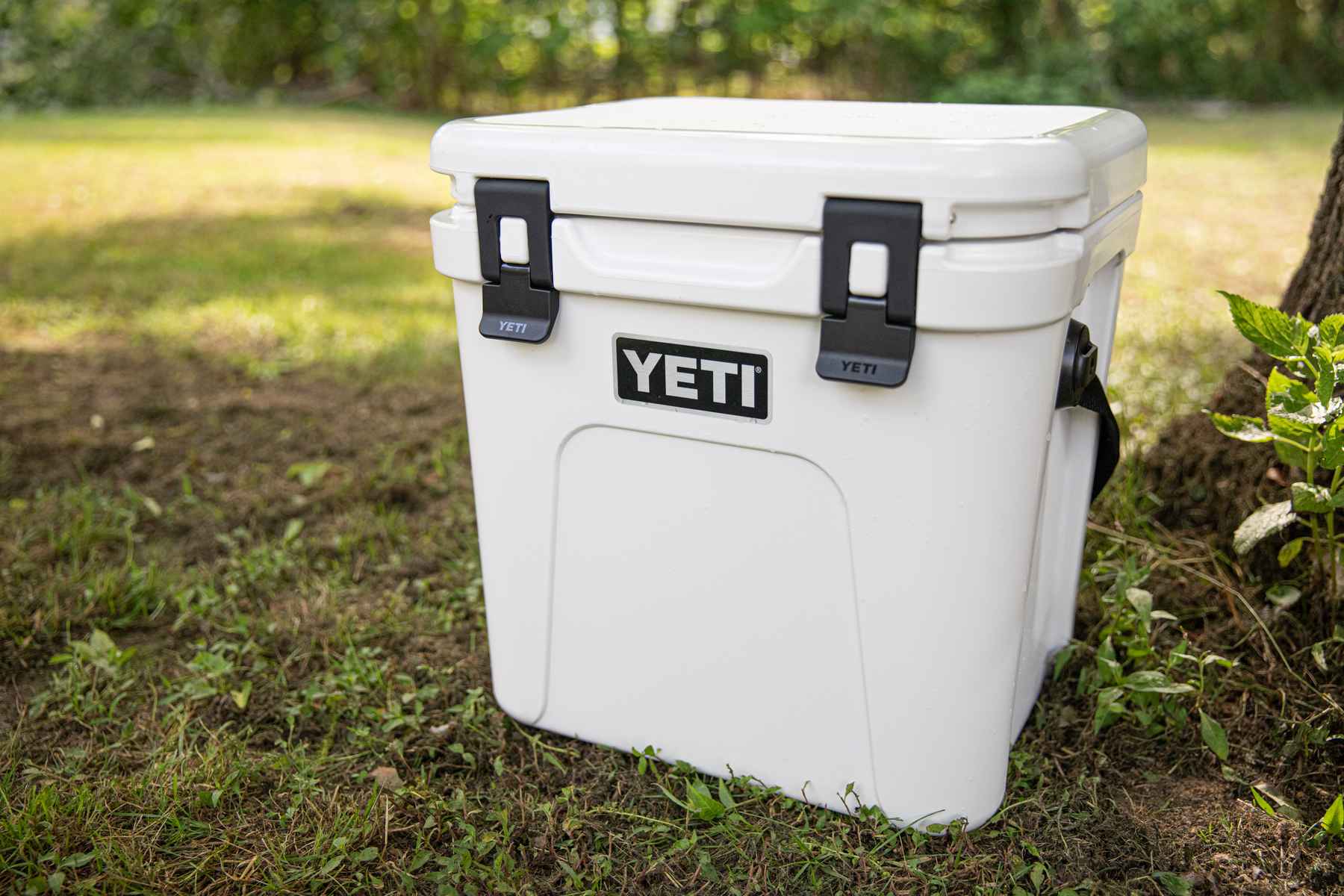
Overall, the YETI Roadie 24 is a great cooler, but it is not the best choice for everyone. If you are looking for the best possible ice retention and insulation, and you do not mind paying a premium, then the Roadie 24 is a great option. However, if you are on a budget or you only need a cooler for storing beer cans, then there are other great coolers available.
2.1. Features
- Rigid rotomolded construction: The YETI Roadie 24 is made of rotomolded plastic, which is a very durable and impact-resistant material.
- 3-inch thick insulation: The YETI Roadie 24 has 3-inch thick insulation, which helps to keep the contents of the cooler cold for longer periods of time.
- Rubber gaskets on the drain plugs: The drain plugs have rubber gaskets to help prevent leaks.
- Two spots for bear locks: The YETI Roadie 24 has two spots for bear locks, which can be used to keep your food secure in bear country.
- Locking mechanism for the stainless steel handle: The stainless steel handle has a locking mechanism to prevent it from accidentally opening.
- Drainage system: The YETI Roadie 24 has a drainage system that makes it easy to drain the melted ice.
- Lifetime warranty: The YETI Roadie 24 comes with a lifetime warranty.
2.2. Things we like
- Durable construction: The YETI Roadie 24 is made of rotomolded plastic, which is a very durable and impact-resistant material.
- Excellent ice retention: The YETI Roadie 24 has 3-inch thick insulation, which helps to keep the contents of the cooler cold for longer periods of time.
- Easy to use: The YETI Roadie 24 is easy to open and close, and it has a drainage system that makes it easy to drain the melted ice.
- Lifetime warranty: The YETI Roadie 24 comes with a lifetime warranty.
- Sleek and stylish design: The YETI Roadie 24 has a sleek and stylish design that makes it a great addition to any outdoor adventure.
2.3. Things we don’t like
- Expensive: The YETI Roadie 24 is one of the most expensive coolers on the market.
- Heavy: The YETI Roadie 24 is not the lightest cooler on the market.
- Not ideal for storing only beer cans: The unique shape of the Roadie 24 makes it not ideal for storing only beer cans.
2.4. Editor’s Note
The YETI Roadie 24 is a high-quality cooler that is known for its excellent ice retention and durability. It is made of rotomolded plastic, which is a very durable and impact-resistant material. It also has 3-inch thick insulation, which helps to keep the contents of the cooler cold for longer periods of time.
The YETI Roadie 24 is also easy to use. It has a sturdy handle and a latching system that makes it easy to open and close. It also has a drainage system that makes it easy to drain the melted ice.
The YETI Roadie 24 is a bit pricey, but it is worth the investment if you are looking for a cooler that will keep your food and drinks cold for days. It is also backed by a lifetime warranty, which gives you peace of mind knowing that your cooler is protected.
2.5. FAQs
2.5.1. How much ice does the YETI Roadie 24 hold?
The YETI Roadie 24 can hold up to 24 cans of soda or beer plus ice. However, the actual amount of ice that the cooler will hold will depend on the type of ice you use, how tightly you pack the cooler, and the ambient temperature.
2.5.2. How long will the ice in the YETI Roadie 24 last?
The YETI Roadie 24 can keep ice cold for up to 3 days in ideal conditions. However, the actual amount of time that the ice will last will depend on the ambient temperature, how often you open the cooler, and how much ice you use.
2.5.3. Is the YETI Roadie 24 bear-proof?
The YETI Roadie 24 is not bear-proof. However, it does have two spots for bear locks, which can be used to secure the cooler in bear country.
2.5.4. What is the warranty on the YETI Roadie 24?
The YETI Roadie 24 comes with a lifetime warranty. This means that YETI will repair or replace the cooler if it ever breaks or malfunctions.
3. Igloo BMX 25
The Igloo BMX 25 is a lightweight cooler that has a lot of carrying capacity. However, it is not the most durable and does not have the best ice retention.
Despite its shortcomings, the Igloo BMX 25 still performs well in terms of insulation and ice retention. It is not far off from the rotomolded coolers, which are more expensive.
Overall, the Igloo BMX 25 is a great cooler for the price. It is lightweight and has a lot of carrying capacity. If you are looking for a budget-friendly cooler, the Igloo BMX 25 is a great option.
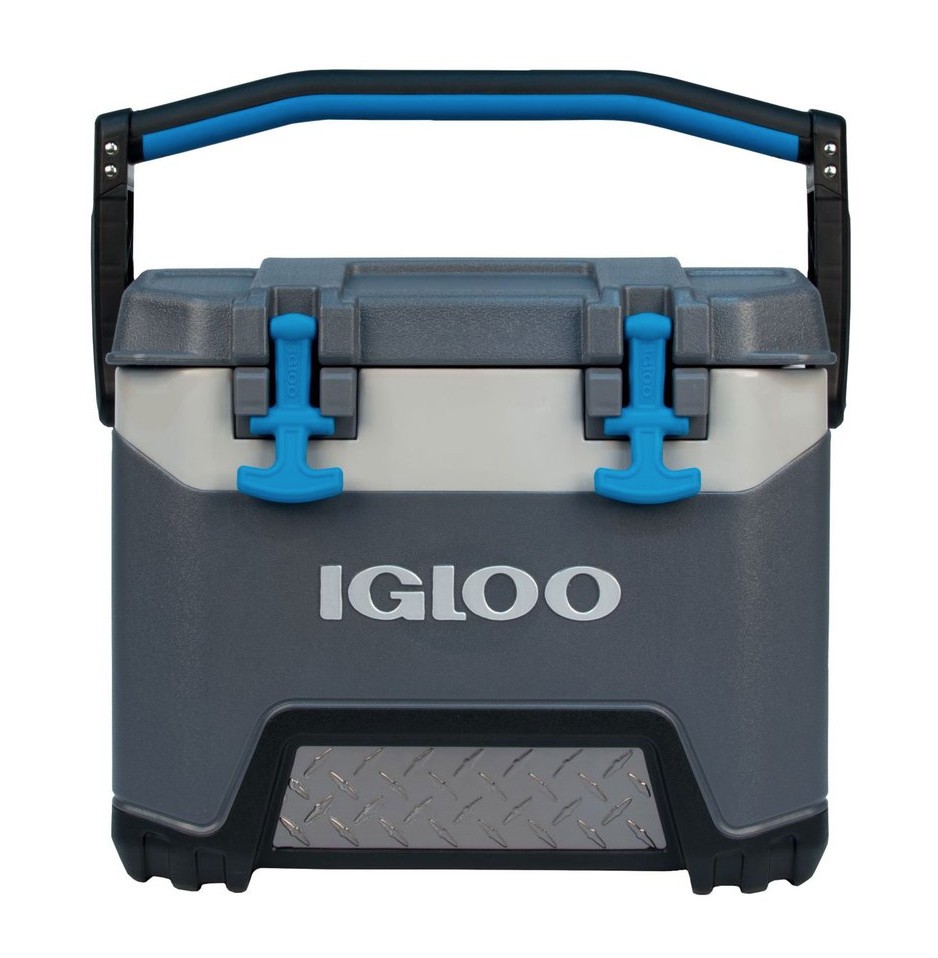
3.1. Feature
- It is made of polyethylene, which is a lightweight and durable material.
- It has a built-in bottle opener.
- It has a rubber gasket to help prevent leaks.
- It is backed by a 5-year warranty.
3.2. Things we like
- Lightweight
- Large capacity
- Good insulation
- Durable construction
- Convenient features
- Affordable
3.3. Things we don’t like
- Not the most durable
- Does not have the best ice retention
- Not as stylish as some other coolers
3.4. Editor’s Note
The Igloo BMX 25 is a lightweight cooler that is perfect for day trips and weekend camping trips. It is made of durable materials and has a large capacity. It also has a number of convenient features, such as a built-in drain plug and a carrying handle.
Overall, the Igloo BMX 25 is a great cooler for the price. It is lightweight, has a large capacity, and is well-insulated. It is a good option for people who are looking for a budget-friendly cooler.
If you are looking for a cooler that is the most durable and has the best ice retention, then you may want to consider a rotomolded cooler. However, if you are looking for a lightweight, well-insulated, and affordable cooler, then the Igloo BMX 25 is a great option.
3.5. FAQs
3.5.1. How much ice does the Igloo BMX 25 hold?
The Igloo BMX 25 can hold up to 25 cans of soda or beer plus ice. However, the actual amount of ice that the cooler will hold will depend on the type of ice you use, how tightly you pack the cooler, and the ambient temperature.
3.5.2. How long will the ice in the Igloo BMX 25 last?
The Igloo BMX 25 can keep ice cold for up to 2 days in ideal conditions. However, the actual amount of time that the ice will last will depend on the ambient temperature, how often you open the cooler, and how much ice you use.
3.5.3. Is the Igloo BMX 25 bear-proof?
The Igloo BMX 25 is not bear-proof. However, it does have a built-in bottle opener.
3.5.4. What is the warranty on the Igloo BMX 25?
The Igloo BMX 25 comes with a 5-year warranty. This means that Igloo will repair or replace the cooler if it ever breaks or malfunctions.
7. What is the difference between a soft-sided cooler and a hard-sided cooler?
The main difference between a soft-sided cooler and a hard-sided cooler is the insulation. Soft-sided coolers are typically made of fabric or vinyl and have a thin layer of insulation. Hard-sided coolers are made of plastic or rotomolded materials and have a thicker layer of insulation.
As a result, hard-sided coolers are better at keeping ice cold for longer periods of time. They are also more durable and can withstand rough handling. However, they are also heavier and more difficult to transport than soft-sided coolers.
Soft-sided coolers are lighter and more portable than hard-sided coolers. They are also less expensive. However, they are not as well-insulated and do not keep ice cold for as long.
Here is a table summarizing the key differences between soft-sided coolers and hard-sided coolers:
| Feature | Soft-Sided Cooler | Hard-Sided Cooler |
| Insulation | Thin layer | Thick layer |
| Durability | Less durable | More durable |
| Weight | Lighter | Heavier |
| Portability | More portable | Less portable |
| Price | Less expensive | More expensive |
8. What is a typical cooler size?
The amount of storage a cooler has is among the most crucial factors that buyers consider.
The size requirements for a camping cooler for a single person will be very different from those for a device that can hold a week’s worth of food and beverages for a big family. Yet size has a price: the cooler will be more difficult to move the larger it is.
Because of this, buying a massive cooler that can hold 150 cans would be ridiculous for someone who only wants enough space to prepare their lunch. While it may seem obvious to have a product that meets your storage demands, there is more to the tale.
There is a significant difference in cooler thicknesses and designs, so even while a cooler may appear to be larger, it may actually have less storage capacity than a thinner, better-shaped competitor.
Moreover, the storage space may not be entirely insulated. Given this, you may not be capable of maintaining as many perishable products as you had planned, even if a specific cooler would promote being larger.
All of the coolers we’ve analyzed have been divided into 5 groupings: personal, small, medium, big, and giant, in an effort to make things more straightforward.
- Personal storage units have a volume of 16 quarts or less.
- Small storage units have 17 to 35 quarts.
- Medium storage units have 36 to 59 quarts.
- Big storage units have 60 to 99 quarts.
- Gigantic storage units have 100 quarts or more.
9. How big should my camping cooler be?
A compact cooler will be more useful if you are only going to be camping for a short period of time, like the weekend. It should, however, be robust enough to endure any bad weather and animals despite being on the smaller side.
You should also search for a model that’s portable. You must be capable of shifting it around easily if you’re going camping alone.
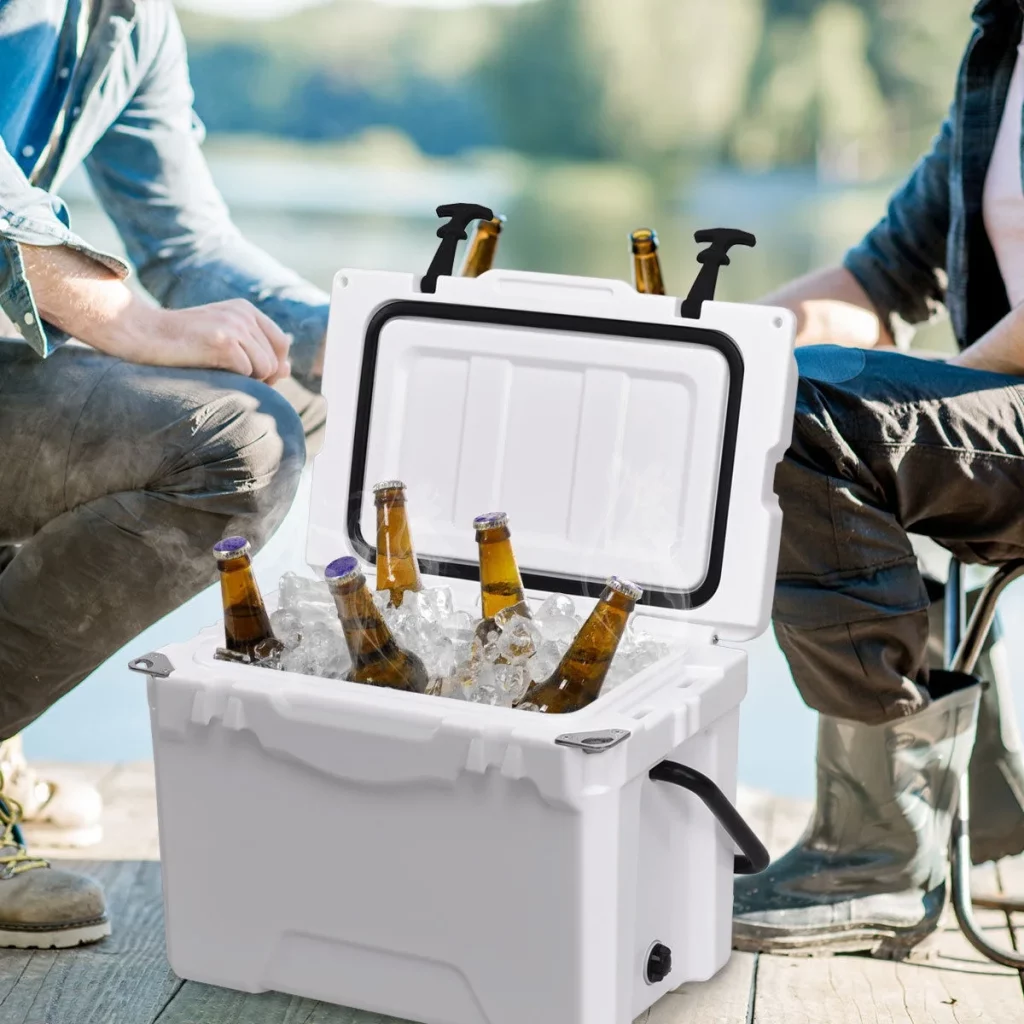
- If you’re going camping for one or two days by yourself, a compact camping cooler (25 gallons) is excellent.
- If you’re going camping alone for three to four days, a medium camping cooler (25–45 gallons) is appropriate. With its current size, it can fit one or two people.
- For a week-long camping vacation, a big camping cooler (45–70 gallons) is recommended. It’ll also be great for a team going camping for the weekend.
“How large of a cooler do I require?” is one of the most typical inquiries we receive in relation to camping coolers. This is a question that only you could answer because the answer is very dependent on the amount you need to pack, for how long, the outside temperature, and a whole host of other considerations.
10. What size cooler suits a party the best?
The number of people you’ll have and the length of your planned gathering will determine the size of coolers you require. A small to medium-sized cooler would do if you usually host small gatherings (under 10 people).
Consider the ENGEL High Performance Backpack Cooler, which has space for ice packs and can accommodate up to 12 cans in addition to a 72 oz bottle in the main compartment. But, if you enjoy throwing huge parties in your backyard (for ten or more guests), you’ll want a big or extra-large cooler to keep drinks cold.
Use this basic guideline when planning a garden party to estimate how many beverages you’ll need: For the first hour, offer each visitor two drinks, and then roughly one drink per hour after that.
Thus, for instance, if you’ll be hosting 5 people for 4 hours, plan to serve 25 beverages altogether. Whether you are providing alcoholic or non-alcoholic beverages, I suggest following this formula. To figure out how many drinks to serve at your party, you may use an online drink calculator.
You’ll need a bigger cooler the bigger your gathering is. Big coolers may hold up to 100 12-ounce cans with ice and normally have capacities between 40 and 100 gallons. When you have 10–20 people on your deck, a large cooler is a great container for cold beverages.
11. How big should the family’s cooler be?
Regular-Sized Cooler (35-55 Quart): This capacity range is the most common, and normally, a size in this range meets the needs of most individuals. This size range is suitable for most commercial applications as well as BBQs, family camping outings, boating, and fishing.
This size is adequate for a case of beer and a few glasses of wine at a barbecue and big enough for all the supplies you’ll need for a tailgate party.
Big Cooler (55-80 Quart): Large groups of people or extended off-grid travels when you need to hold more and have your ice stay longer are appropriate uses for these larger coolers. With this big, high-quality cooler, the ice will last 5–10 days or more.
The thinner soft-sided coolers are likely ideal for a tailgate or beverages for a group, and a 70-quart capacity is typically the most family-friendly.
12. How should I put my cooler together in the best way?
- The cooler should be chilled before packing:
Ice keeps longer in a cooler. Let the cooler stay the night inside a commercial freezer if you have access to one. For everyone else, store it in the coldest area of your home the evening before your travel, or leave it on your porch overnight.
- Freeze your meals and beverages:
Pack frozen steak and chicken if you intend to have them on the third night, and allow them to defrost over time. They’ll add to the overall chill and be prepared in plenty of time. Water and other non-carbonated drinks are the same. As soon as you get to camp, take the frozen bottles out of the cooler to defrost.
- Use ice blocks rather than ice cubes:
You can make ice blocks yourself by chilling water in Tupperware. These require more labor than conventional cubes and require a pick or hammer to break off pieces, but because of their greater mass, they don’t melt as quickly.
- Layer your bags:
Fill the cooler with ice blocks, then top off the ice with a thin, solid layer, such as the edge of a milk box or a piece of cardboard. Food is prevented from seeping between the ice and becoming mushy by this barrier.
- Add another insulation layer:
Even if you have a cooler, it doesn’t hurt to add extra insulation to protect your food from the sun’s rays. Some individuals cut used sleeping mats into rectangles the size of coolers.
- Keep it closed and latches:
Less chilly air will escape from your cooler if it is completely shut while not in use. Open the cooler to get what you need, then close it right away to prevent wasting cold, healthy air.
- Maintain discrete and organized food storage:
You’ll be able to browse everything a lot more quickly if each sort of food has its own section—meat, veggies, condiments, etc.—and you are aware of where everything is.
- Keep it inside:
Your cooler may be built to endure a falling tree; however, it wasn’t made to withstand prolonged exposure to the sun, which might degrade the plastic. The item will live forever if you put it in the garage.
13. How is a cooler measured?
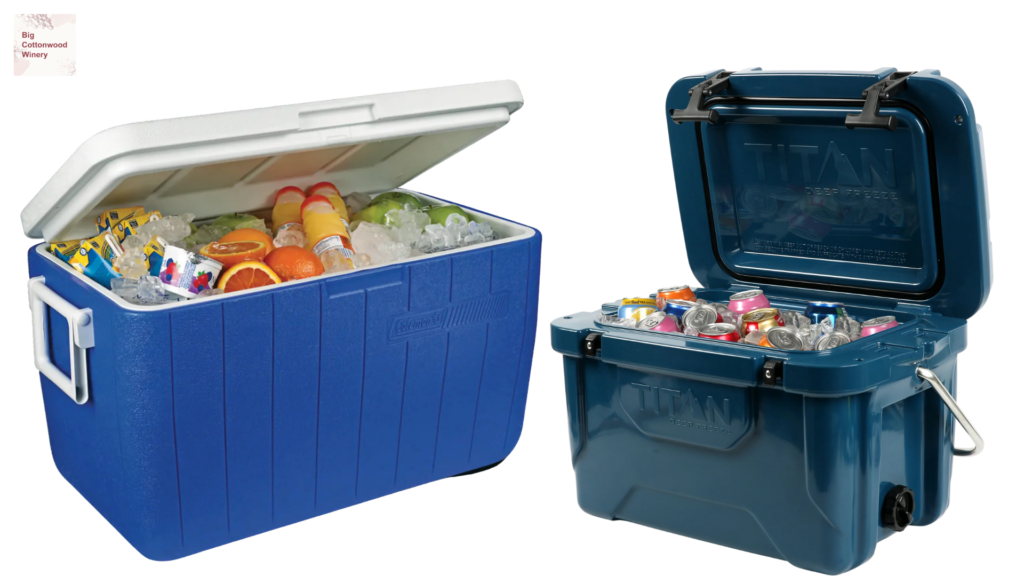
Below are the definitions of each of those metrics for cooler capacity.
- Quarts
A quart is one-fourth of a gallon. Quart cooler sizes, such as a 24-quart or 70-quart cooler, are frequently offered with products. It might be easier to visualize the size of a 24-quart cooler (for example) if you think of it as being equivalent to around 6 gallons of space.
But a 24-quart cooler might not be able to accommodate 6-gallon jugs of milk or water. The packaging also takes up some space for most packaged goods, such as milk bottles and soda cans.
- Cans
Another method of measuring cooler capacity uses cans. When a cooler’s capacity is indicated by a quantity of cans, it refers to a typical 12-oz soda can.
- Also, you may use the All-In Liner liner size calculator, which uses the cooler’s specifications to direct you to the page where you can get the precise plastic protection liner for your cooler or ice chest. Measure the cooler’s dimensions and enter it into the calculator if you have one. Don’t forget to measure the cooler’s inside.
Many things affect the capacity of a cooler:
A 24-quart cooler won’t always accommodate 24 1-quart bottles, as was already explained. That’s because, among other things, the form of the food and beverages you’re putting in the cooler might affect the cooler’s capacity. These are some things to remember:
- Content’s size: Bigger, bulkier products will require more room inside the freezer than smaller ones.
- Shape of contents: Certain goods, such as juice boxes or soda bottles, can stack inside a cooler evenly, however other items, such as food products or glass containers, may be more challenging to arrange in an even stack.
- Ice: Include ice or ice packs with your food and drink to ensure that your cooler operates at its best. Moreover, ice will take up room within the cooler.
14. FAQs
1. Is Coleman or Igloo better?
In conclusion, Coleman is a better choice for anyone on a tight budget who still wants strong ice retention efficiency and practical amenities like cup holders, tires, etc. Igloo, on the other hand, is the superior brand for individuals who want a little more of an upscale, robust, athletic cooler.
2. Do you put ice or beer first in the cooler?
Drinks should be added before ice. Use some science while you fill your cooler or party pool to keep your beverages colder: Place your cans and bottles in the cooler first, then add ice on top of them.
3. Why add salt to the ice in a cooler?
Why do they do this, then? Why does salt dissolve snow and ice? The mechanism of freezing point depression causes salt to lower the freezing point of water. When salt is added, the temperature at which water ordinarily freezes might fall as low as 20 °F. You may get perfectly cold beverages in 30 minutes by lowering the freezing point of melting ice with salt.
4. How many beers are in a 20-quart cooler?
Drinks will fit comfortably in a cooler with an actual capacity of twenty quarts. This cooler is large enough to hold 15 cans of beer or soda, even when you adhere to the 2:1 ratio of ice to goods—regardless of whether you’re using traditional 12 oz cans or the taller, slimmer cans.
5. How many gallons is a Yeti 20 cooler?
It is the tiniest hard cooler and is quite lightweight to carry all day. The Roadie 20 holds 16 cans or 20 pounds of ice. It has a liquid capacity of 4.14 gallons or 19.9 quarts. If you keep a 2:1 ice to liquid ratio, it can hold up to 14 beer cans and has such strong insulation that it nearly seems to flout the rules of thermodynamics.
6. What is the size of a 20-quart cooler?
The dimensions of a 20-quart cooler can vary depending on the brand and model. However, a typical 20-quart cooler will be about 18 inches long, 12 inches wide, and 10 inches high.
7. How many food items can a 20-quart cooler hold?
A 20-quart cooler can hold about 30 pounds of food. However, the actual amount of food that the cooler will hold will depend on the size and shape of the food items.
9. Conclusion
Because everyone has different needs, we were unable to analyze every size of the cooler. Instead, we made the decision to concentrate on the most practical and family-friendly sizes that we could locate. We hope that after reading this page you will be able to select the finest cooler for your needs and know the answer to the question: “How big is a 20-quart cooler?”

In 2014, Leo Colon began working with Big Cottonwood Winery. Over the years he has remained part of this prestigious winery’s team and is also a contributor to other notable wine publications. As an ardent advocate for knowledge, Leo continues his vinous education to this day.

